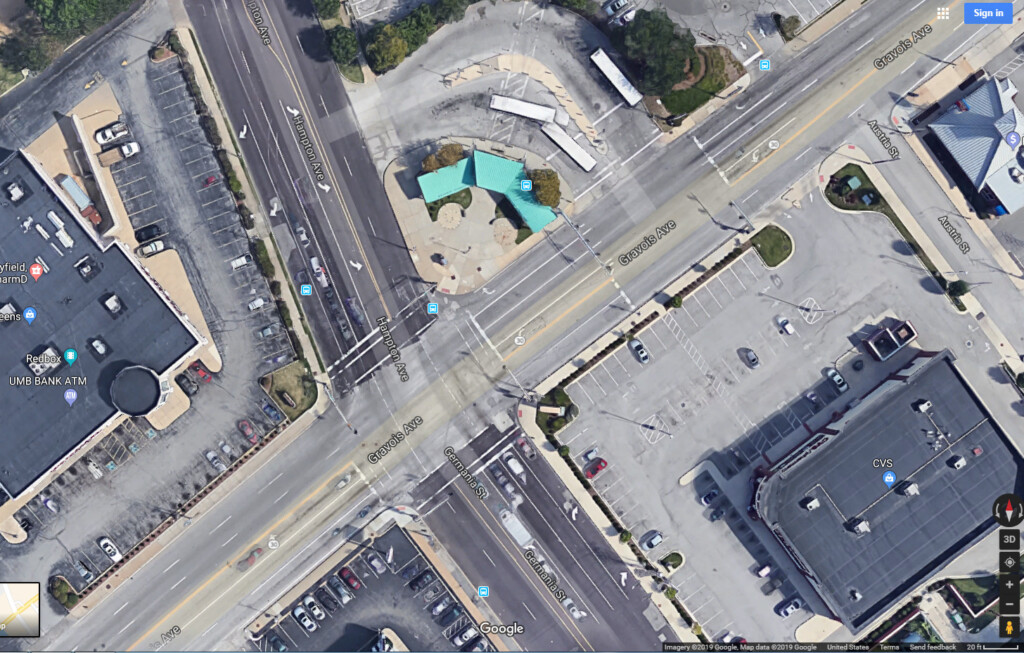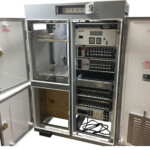Missouri DOT (MoDOT) had a problem. Their intersections were getting more complex, but their traffic-control cabinet hardware wasn’t able to support their changing needs. The existing cabinets couldn’t support more than 16 output channels to control the intricate phasing of their intersections. The solution? A 32-channel 350 ATC cabinet.
For a recent project in St. Louis, MoboTrex supplied MoDOT with a 350 ATC cabinet to handle the complex intersection at MO30/Gravois Avenue and Hampton Avenue/Germania Street. This intersection includes pedestrian signals, left and right turn lanes, dedicated bike lanes, and nearby access to a bus depot and several commercial businesses.

Google Maps view of Gravois & Hampton/Germania intersection
The ATC cabinet standard allows for control of up to 32 output channels with a single conflict monitor, so it was an ideal choice for this intersection.
MoDOT let a project to upgrade the intersection and signalize not just the Hampton/Germania and Gravois crossing, but the access point to the bus depot as well. With all these approaches and flashing yellow arrows included, MoDOT engineers were quickly running out of output channels to handle all the phases they wanted to control. MoboTrex helped MoDOT develop specifications for a new ATC cabinet that met their user needs and could handle both sets of signals in a single cabinet. The ATC cabinet standard allows for control of up to 32 output channels with a single conflict monitor, so it was an ideal choice for this intersection.
This was MoDOT’s first experience with an ATC cabinet, and they were able to evaluate its effectiveness in a live environment. This also provided their technicians with training and real-world experience with the new cabinet architecture, as most MoDOT cabinets currently adhere to the NEMA TS2 standard.
The ATC cabinet standard was developed by a joint committee of NEMA, AASHTO, and ITE with a working group comprised of public and private sector members. The working group used a systems engineering process to collect feedback from the public sector members and then developed these needs into a national standard. User needs were prioritized, including technician and public safety, ease of maintenance, increasing value to end users, flexibility for innovative designs, and higher density components.

Eagle 350 ATC Cabinet
The new national ATC standard (ITE designation ATC 5301 v02) allows cabinet manufacturers more room for innovation than ever before. The result is a cabinet architecture that includes these key design features:
- High density components – more functionality in a smaller space
- Modular assemblies – simple to expand for more inputs or outputs when needed
- Fail-safer technology – improved safety for motorists, bicyclists, and pedestrians
- Enhanced troubleshooting and diagnostic tools – find the problem and fix it quickly
- Improved technician safety – remove 120VAC wherever possible and protect maintenance personnel from shock hazards
- Increase monitoring functionality – control and monitor up to 32 output channels in a single cabinet
- Offer standard 48VDC output option
The ATC standard was intended to capture the best of all worlds, including features from the NEMA TS2, Caltrans, and ITS v1 standards and combining them with more modern technology to bring the traffic cabinet into the 21st century.
As intersections become more complex, the ATC cabinet is an innovative and valuable tool that will fit well in any traffic engineer’s toolbox for future projects.
Brent Katauskas, P.E., Channel Sales Director
(512) 521-3081
